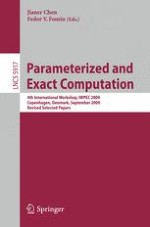2009 | Book
Parameterized and Exact Computation
4th International Workshop, IWPEC 2009, Copenhagen, Denmark, September 10-11, 2009, Revised Selected Papers
Editors: Jianer Chen, Fedor V. Fomin
Publisher: Springer Berlin Heidelberg
Book Series : Lecture Notes in Computer Science
